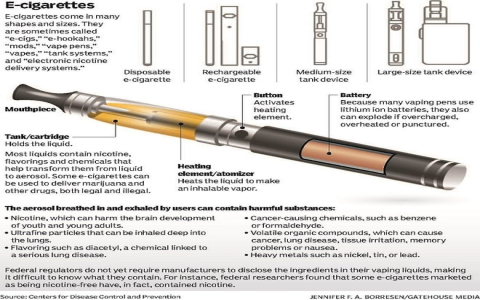Both e-cigarettes and combustible cigarettes pose health risks, though significant differences exist in the chemicals inhaled and associated harm levels based on current evidence.
Chemical Exposure: Key Differences
- Cigarettes: Combustion generates over 7,000 chemicals, including at least 70 known carcinogens (e.g., tar, benzene, formaldehyde). Heavy metals like cadmium and arsenic are present.
- E-cigarettes: Produce an aerosol by heating a liquid. Contains significantly fewer toxicants and lower levels than cigarette smoke, but still includes ultrafine particles, flavoring chemicals (e.g., diacetyl linked to lung disease), volatile organic compounds (VOCs), and sometimes heavy metals from the device.
Health Risks: Combustible vs. Aerosol
- Cigarettes: Cause the vast majority of tobacco-related death/disease. Proven link to lung cancer, COPD, heart disease, stroke, multiple other cancers, and severely compromised immune function.
- E-cigarettes: Considerably less harmful than smoking for adults who completely switch. Not risk-free. Associated with increased heart rate, blood pressure, lung irritation, potential contribution to chronic lung disease/cardiovascular disease, and EVALI (linked primarily to THC oils/vitamin E acetate). Long-term effects (10+ years) remain under study.
Nicotine and Addiction
Both deliver highly addictive nicotine. E-cigarettes can deliver comparable or even higher doses, fueling dependence. Youth using e-cigarettes are ~3x more likely to start smoking cigarettes.

Smoking Cessation: E-cigs as a Tool
Evidence shows e-cigarettes can be more effective than NRT for some adult smokers quitting completely. However, most successful quitters using e-cigarettes eventually aim to stop vaping too. Dual use (vaping + smoking) offers minimal health benefit and increases risk.
Key Considerations
- Never Use Either: E-cigarettes are NOT safe for non-smokers, youth, or pregnant women.
- Not FDA-Approved NRT: While a cessation tool for some, e-cigarettes are not approved smoking cessation medications like patches or gum.
- Device & Liquid Risks: Explosion risk exists. Flavorings lack safety data for inhalation. Contaminants are possible.
Bottom Line: For adult smokers unable to quit otherwise, switching completely to regulated e-cigarettes reduces exposure to deadly toxicants compared to continued smoking. Quitting all nicotine products is the safest option. Non-smokers should never start.









